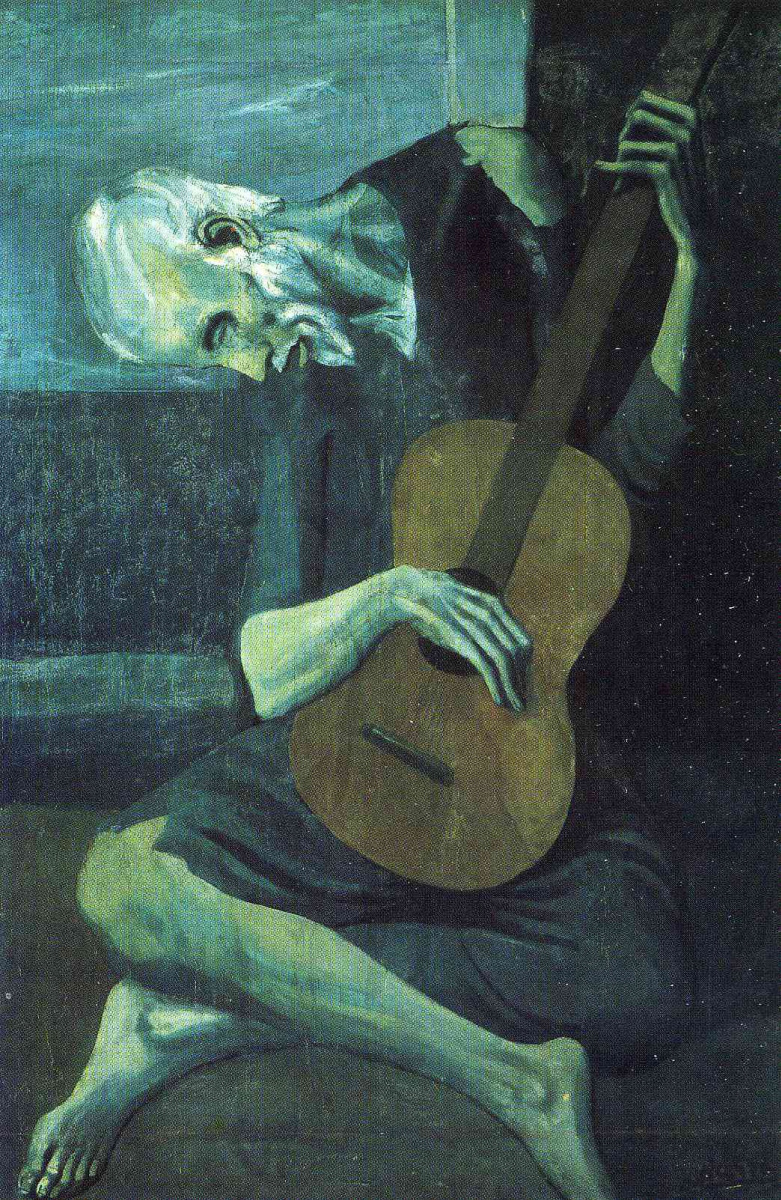log in
Enter site
Login to use Arthive functionality to the maximum
The old guitarist
Pablo Picasso • Painting, 1904, 123×83 cm
Description of the artwork «The old guitarist»
In 1898, Picasso said goodbye to the Royal Academy of Fine Arts, which had completely bored him, and returned from Madrid to Barcelona. That's where a real life was! There were creative freedom, the first solo exhibitions in the famous cafe "Four Cats" and like-minded friends, with whom one could both discuss art and go on a spree in brothels. The closest of them was Picasso's peer, artist Carlos Casagemas. They were almost inseparable, and Pablo with all his might supported a friend who suffered from unrequited love. But it all ended tragically: Carlos tried to shoot a girl who did not reciprocate, and then committed suicide.
After this sad event, the "blue period" in the work of Picasso started. Until the end of his days, the artist blamed himself for the death of his friend and believed that he could have prevented Casagemas' suicide. In 1901, he painted several paintings in a row, depicting Carlos in a coffin (1, 2), but art historians also find similar features in the subjects of Picasso's later paintings. Be that as it may, the death of a friend influenced the artist so much that only work could save him as he bersted out his depression and despair on the canvas. Almost all canvases of Picasso’s "blue period" bear this invisible imprint of death. Picasso's The Old Guitarist painting was not an exception.
At the first glance at this work, one gets the impression that the blind musician was captured at the moment when he died quietly, not having time to finish playing the song to the end. He looks like a ghost, almost merging with the background, his unnaturally bent figure is broken, either by the agony of death, or by the agony of longing. The gloomy palette enhances this effect. Only the guitar seems alive on this canvas: the viewer can almost hear the piercing chords that turn the soul inside out. It is noteworthy that behind the Old Guitarist a ghostly woman's face looms from under a paint layer. At that time, Picasso could not always find money for a new canvas, so he had to paint one picture on top of another.
In 1937, the American poet Wallace Stevens wrote "The Man with the Blue Guitar" poem, which is considered a tribute to The Old Guitarist." In a poetic dialogue between the musician and his audience, Wallace puts into words Picasso's conviction that art is a lie that helps us see the truth.
Written by Yevgheniya Sidelnikova
After this sad event, the "blue period" in the work of Picasso started. Until the end of his days, the artist blamed himself for the death of his friend and believed that he could have prevented Casagemas' suicide. In 1901, he painted several paintings in a row, depicting Carlos in a coffin (1, 2), but art historians also find similar features in the subjects of Picasso's later paintings. Be that as it may, the death of a friend influenced the artist so much that only work could save him as he bersted out his depression and despair on the canvas. Almost all canvases of Picasso’s "blue period" bear this invisible imprint of death. Picasso's The Old Guitarist painting was not an exception.
At the first glance at this work, one gets the impression that the blind musician was captured at the moment when he died quietly, not having time to finish playing the song to the end. He looks like a ghost, almost merging with the background, his unnaturally bent figure is broken, either by the agony of death, or by the agony of longing. The gloomy palette enhances this effect. Only the guitar seems alive on this canvas: the viewer can almost hear the piercing chords that turn the soul inside out. It is noteworthy that behind the Old Guitarist a ghostly woman's face looms from under a paint layer. At that time, Picasso could not always find money for a new canvas, so he had to paint one picture on top of another.
In 1937, the American poet Wallace Stevens wrote "The Man with the Blue Guitar" poem, which is considered a tribute to The Old Guitarist." In a poetic dialogue between the musician and his audience, Wallace puts into words Picasso's conviction that art is a lie that helps us see the truth.
Written by Yevgheniya Sidelnikova



